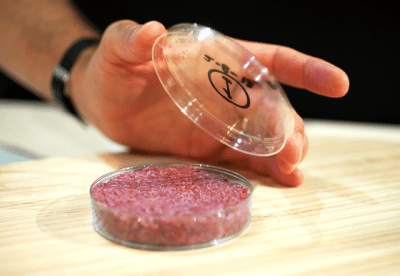IF the cultured meat industry is to fully mature, production facilities would look similar to breweries, according to Michael Selden, co-founder of Finless Foods, an early-stage cultured fish protein start-up company.
 Cultured meat — not to be confused with the plant-based meat alternatives consistently making headlines for cooking, tasting and bleeding like meat — is the result of cellular agriculture. This is a process that’s been used for years in the medical field, that can grow real animal tissue, and has only recently been reimagined for food production.
Cultured meat — not to be confused with the plant-based meat alternatives consistently making headlines for cooking, tasting and bleeding like meat — is the result of cellular agriculture. This is a process that’s been used for years in the medical field, that can grow real animal tissue, and has only recently been reimagined for food production.
Three players in the very small, but growing, cultured meat club spoke together on a panel at the Reducetarian Summit in New York City last month. Also speaking were Mark Post of Mosa Meat, and David Kay of Memphis Meats, who are working on bringing lab-grown beef and chicken protein products to market, respectively.
Mr Selden said the brewery-like production facilities he described could be open for public tours like many breweries are today, democratising meat production in a way unheard of in today’s meat industry. But, that’s still quite a few years in the future; the clear barrier is not creating meat in a lab, it is scaling the process, the panel agreed.
The technology that makes cultured meat possible is adopted from the medical field, with early versions going all the way back to 1922. Mr Post said it had never been done at scale before and that’s what these three companies, plus a few more, like New Wave Foods, have to crack.
The tech side is what will allow for the necessary scale. The cellular agriculture process contains two main phases and the second phase, according to Mr Post, is labour intensive.
He said it will require automated solutions to keep labour costs, and retail prices, down. Genetic modification could make the process easier and faster, but it’s currently prohibited in the US by the Food and Drug Administration (FDA), Mr Selden said.
So, though scale is the toughest nut to crack, the price of these alternative meats cannot drop without it. Mosa Meat’s lab-grown burger, which received widespread media coverage in 2013, cost around US$1.2 million per pound to produce. Mr Kay said the last publicised cost of Memphis Meats’ chicken was US$6000 per pound and has dropped since. So progress is steady, but there is still quite a way to go to compete with even the poshest organic, heritage bird.
“The ultimate end-goal of Memphis Meats… is to have meat that is accessible to everybody, but doesn’t come with the problems associated with conventionally produced meat.”
Mr Kay said that ultimately he would like it to be more affordable than conventional meat.
Memphis Meats won’t make it to market until 2021, he said, and even then, the company’s cultured chicken will be priced at a premium. Notably, this is in line with what co-founder Uma Valenti told AgFunderNews at the time of their $2.75 million seed-funding round in early 2016. The other companies echoed a similar timeline, but all agreed that projections are contingent on technology and funding.
Though the pace may be frustratingly slow for those who want a taste, the industry leaders are still confident that cellular agriculture is the future of meat.
Mr Post predicted that it would one day completely replace livestock farming, suggesting that consumers would look back on the time that animals were raised and slaughtered for food as a sort of ‘dark-ages.’
Mosa Meat is currently raising its first round of funding.
Source: AgFunderNews
